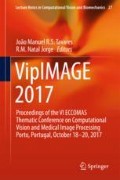Abstract
Cavity volume is an important clinical index for the assessment of the healing process and effectiveness of treatment applied on chronic ulcers. Recently, 3D scanners have proven to effectively track ulcer’s volume evolution. However, photogrammetry presents itself as a low cost and portable alternative. We conducted an inter-laboratory comparative study between photogrammetric and 3D scanner-based volume estimation of small skin ulcers. A total of 20 Cutaneous Leishmaniasis ulcers’ virtual models were generated using a commercial laser scanner and a full-HD portable camera. The reconstruction from videos was performed using comercial and open-source software (i.e., Agisoft Photoscan and VisualSFM). The results revealed similar performance with a median deviation of 16.18% and 21.10% (compared to 3DScan-based volume estimation) using VisualSFM and PhotoScan respectively. In addition, both methods proved similar efficiency in the assessment of healing ulcers when compared to 3D-scanner.
Access this chapter
Tax calculation will be finalised at checkout
Purchases are for personal use only
References
Little, C., McDonald, J., Jenkins, M.G., McCarron, P.: An overview of techniques used to measure wound area and volume. J. Wound Care 18(6), 250–253 (2009)
Jørgensen, L.B., Sørensen, J.A., Jemec, G.B., Yderstræde, K.B.: Methods to assess area and volume of wounds - a systematic review. Int. Wound J. 13, 540–553 (2016)
Plassman, P., Jones, T.: MAVIS: a non-invasive instrument to measure area and volume of wounds. Med. Eng. Phys. 20(5), 332–8 (1998)
Malian, A., van den Heuvel, F., Azizi, A.: A robust photogrammetric system for wound measurement. Int. Arch. Photogramm. Remote Sens. 34, 264–269 (2002)
Jones, B.F., Plassmann, P.: An instrument to measure the dimensions of skin wounds. IEEE Trans. Biomed. Eng. 42(5), 464–70 (1995)
Ozturk, C., Dubin, S., Schafer, M., Shi, W.Y., Chou, M.C.: A new structured light method for 3-D wound measurement. In: IEEE Twenty-Second Annual Northeast, pp. 70–71. IEEE (1996)
Krouskop, T., Baker, R., Wilson, M.: A noncontact wound measurement system. J. Rehabil. Res. Dev. 39, 337–346 (2001)
Callieri, M., et al.: Derma: monitoring the evolution of skin ulcers with a 3D System. In: Vision Modeling and Visualization, pp. 167–174 (2003)
Malian, A., Azizi, A., Van Den Heuvel, F.A.: Medphos: a new photogrammetric system for medical measurement. ISPRS Congr. 35, 311–316 (2004)
Plassmann, P., Jones, C., McCarthy, M.: Accuracy and precision of the hand-held MAVIS wound measurement device. Int. J. Low Extrem. Wounds 6(3), 176–90 (2007)
Putzer, D., et al.: Assessment of the size of the surgical site in minimally invasive hip surgery. Adv. Wound Care 3(6), 438–444 (2014)
Zvietcovich, F., Castaneda, B., Valencia, B., Llanos-Cuentas, A.: A 3D assessment tool for accurate volume measurement for monitoring the evolution of cutaneous leishmaniasis wounds. In: IEEE International Conference of EMBC, pp. 2025–2028 (2012)
Pavlovčič, U., Diaci, J., Možina, J., Jezeršek, M.: Wound perimeter, area, and volume measurement based on laser 3D and color acquisition. BioMed. Eng. OnLine 14(1), 39 (2015)
Treuillet, S., Albouy, B., Lucas, Y.: Three-dimensional assessment of skin wounds using a standard digital camera. IEEE Trans. Biomed. Eng. 25(5), 752–762 (2009)
Wannous, H., Lucas, Y., Treuillet, S.: Enhanced assessment of the wound-healing process by accurate multi-view tissue classification. IEEE Trans. Biomed. Eng. 30(2), 315–326 (2011)
Nixon, M., Rivett, T., Robinson, B.: Study: assessment of accuracy and repeatability on wound models of a new hand-held, electronic wound measurement device. In: Symposium for Advanced Wound Care SAWC (2012)
Hettiarachchi, N.D.J., et al.: Mobile based wound measurement. In: IEEE Point-of-Care Healthcare Technologies, pp. 298–301 (2013)
Foltynski, P., Ladyzynski, J., Wojcicki, M.: A new smartphone-based method for wound area measurement. Artif. Organs 38(4), 346–352 (2014)
Wang, L., et al.: Smartphone-based wound assessment system for patients with diabetes. IEEE Trans. Biomed. Eng. 62(2), 477–488 (2015)
Hartley, R., Zisserman, A.: Multiple View Geometry in Computer Vision, 2nd edn. Cambridge University Press, Cambridge (2003)
Wu, C.: Towards linear-time incremental structure from motion. In: 2013 IEEE International Conference on 3DTV-Conference, pp. 127–134 (2013)
Cignoni, P., Callieri, M., Corsini, M., Dellepiane, M., Ganovelli, F., Ranzuglia, G.: MeshLab: an open-source mesh processing tool. In: Eurographics Italian Chapter Conference, pp. 129–136 (2008)
Kazhdan, M., Hoppe, H.: Screened poisson surface reconstruction. ACM Trans. Graph. (TOG) 32(3), 29 (2013)
Acknowledgements
The authors would like to thank Ana Saavedra and Julien Rouyer for their assistance in scanning and patient handling. This work was supported by IMPULSO (Image Processing of Skin Ulcers in Tropical Areas) project funded by STIC-AmSud program.
Author information
Authors and Affiliations
Corresponding author
Editor information
Editors and Affiliations
Rights and permissions
Copyright information
© 2018 Springer International Publishing AG
About this paper
Cite this paper
Zenteno, O. et al. (2018). Volume Estimation of Skin Ulcers: Can Cameras Be as Accurate as Laser Scanners?. In: Tavares, J., Natal Jorge, R. (eds) VipIMAGE 2017. ECCOMAS 2017. Lecture Notes in Computational Vision and Biomechanics, vol 27. Springer, Cham. https://doi.org/10.1007/978-3-319-68195-5_79
Download citation
DOI: https://doi.org/10.1007/978-3-319-68195-5_79
Published:
Publisher Name: Springer, Cham
Print ISBN: 978-3-319-68194-8
Online ISBN: 978-3-319-68195-5
eBook Packages: EngineeringEngineering (R0)

